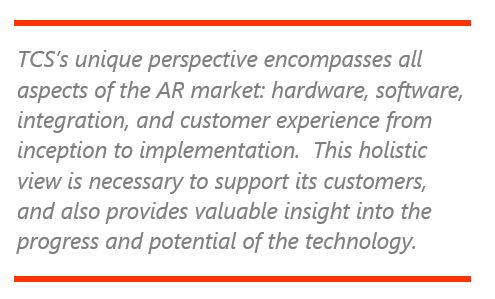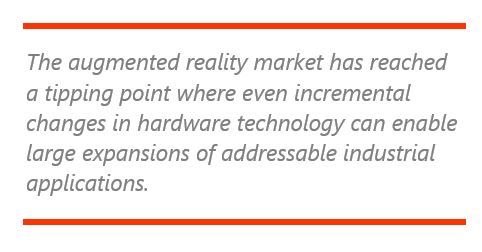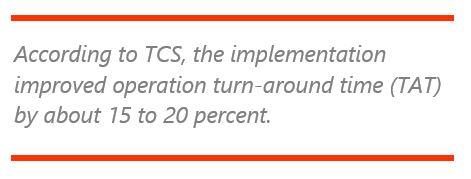


Software: AR solutions are becoming feasible to build and implement as organizations embrace digital strategies across their enterprises.
Hardware: AR hardware is maturing rapidly and by pairing with a holistic AR software platform is increasing the breadth of practical AR applications and rate of adoption.
Applications: AR adoption is finding good traction across both discrete and process industries with engineering, manufacturing, maintenance, and field service applications.
Effective augmented reality applications can be straightforward to conceptualize, create, and implement. With modern authoring tools, developers can create immersive AR experiences. Likewise, easy-to-implement remote expert applications can have tremendous impact on maintenance and field service operations. However, these basic applications only represent a small step towards the transformational potential of industrial AR.

TCS is working with customers and software suppliers to meet this vision. The most impactful engagements are of medium to high complexity, where the customer describes its pain point and TCS conceives a connected AR solution that aligns with the company’s digital roadmap. In our briefing, TCS explained that companies take a two-stage approach when adopting AR. First, they evaluate technology to find the best fit for optimizing their internal operations and second, they must integrate with enterprise systems or build use cases that span multiple functions in the value chain. Programs often require TCS to engage with IT and other business function stakeholders, enterprise software providers, and AR hardware and software suppliers. Careful coordination between these groups is essential to build robust and effective system architectures. The process is often complex and can vary greatly depending on the desired outcome and stakeholders involved. However, TCS believes that its well-defined solution framework makes it easier to connect disparate data silos as companies reorganize around IoT or other digital transformation-based agendas.
Connecting disparate data sources is one obstacle along the path to create truly transformative AR solutions. At some point, however, the connected digital world must intersect with the real world. It is at this intersection that the value of information is realized through action and where hardware technology becomes a key enabler of AR applications.
However, AR hardware is relatively immature, made feasible only in the last decade by leaps in mobile computing technology. The driving economic force has been the buying power of the consumer sector and most advances have been applied to satisfy that market. With the surge of digital transformation initiatives, mobile hardware suppliers have begun to address the specific needs of industrial customers. Now, the AR market has reached a tipping point where even incremental changes in hardware technology can enable large expansions of addressable industrial applications.
While there is a wide variety of AR hardware, no single product or form factor can address the entire industrial market. Cost, safety, weight, ruggedization, display type, sensing capabilities, and battery life are examples of a much longer list of considerations when selecting hardware. Being vendor agnostic, TCS can take a strategic, case-by-case approach to hardware selection.
During our briefing, TCS shared several industrial AR solution use cases. Two of these lined up particularly well with ARC’s vision of the future.
In manufacturing, TCS has developed an AR application for the connected shop floor engineer and supervisor that focuses on manufacturing production and quality. By integrating the IoT-based AR application platform with its customer’s MES application, the TCS solution provides individualized manufacturing visualization for operators, supervisors, and quality engineers. The solution enables real-time operational data visibility and contextual view of data and analytical insights to support better decision making at the plant floor. TCS’s knowledge of data and processes ensured the solution was highly scalable and replicable to different sites. According to TCS, the implementation improved operation turn-around time (TAT) by about 15 to 20 percent.

In both cases, value was generated by ensuring that the right information was provided to the worker on the factory floor or in the field in the right context and at the right time. This was made possible by integrating the AR platform with established manufacturing, operational, and equipment maintenance data sources.
The industrial AR market is already transforming how plant and manufacturing personal interact with information. However, rather than looking at AR in an isolated manner, it’s important to take a holistic approach to achieve the potential benefits that can be gained by creating a connected digital enterprise. For those readers who remain skeptical about this potential, just consider the mobile phone market of the mid-2000s. Back then, very few people had the foresight to look at a Blackberry or flip-phone and envision the way smart phones would change how people and businesses operated. Those who did were in a better position to leverage the technology as it emerged to disrupt the industries they competed in. Today, we believe AR is in a similar situation.
ARC Advisory Group clients can view the complete report at ARC Client Portal
If you would like to buy this report or obtain information about how to become a client, please Contact Us
Keywords: Augmented Reality, Engineering, Manufacturing, Field Service, TCS, ARC Advisory Group.

